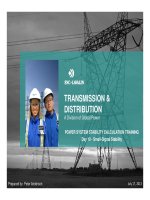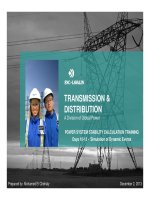Phần 21 KHÓA ĐÀO TẠO TÍNH TOÁN ỔN ĐỊNH VÀ ỨNG DỤNG TRÊN PHẦN MỀM PSSE CHO KỸ SƯ HỆ THỐNG ĐIỆN (Ổn định kích thích nhỏ và ứng dụng trên Phần mềm PSSE)
Bạn đang xem bản rút gọn của tài liệu. Xem và tải ngay bản đầy đủ của tài liệu tại đây (5.96 MB, 61 trang )
TRANSMISSION &
DISTRIBUTION
A Division of Global Power
POWER SYSTEM STABILITY CALCULATION TRAINING
D10
Sll
Si l St bilit
D
ay
10
-
S
ma
ll
-
Si
gna
l
St
a
bilit
y
July17,2013
Prepared by: Peter Anderson
eBook for You
SMALL
SIGNAL STABILITY
2
SMALL
-
SIGNAL
STABILITY
Transient Stability:
Ti D i A l i
Ti
me
D
oma
i
n
A
na
l
ys
i
s
Stepwise Integration of Differential Equations
Small-Signal Stability
FDiAli
F
requency
D
oma
i
n
A
na
l
ys
i
s
Eigen Value/Vector Analysis using Linearized
Differential Equations
Differential
Equations
eBook for You
APPLICATIONS
3
APPLICATIONS
Power System Size
I i th h G th i I t ti
I
ncreas
i
ng
th
roug
h
G
row
th
i
n
I
n
t
erconnec
ti
ons
Driven by Potential Cost Savings (Economies of
Scale, Use of Lowest
-
cost Generating Units)
Scale,
Use
of
Lowest
cost
Generating
Units)
Focus on Generation-Not on Transmission
Disadvantages
Increased Vulnerabilit
y
y
Inter-Area Oscillations
System Disintegration/Widespread Blackouts
eBook for You
EIGEN
-
VALUE ANALYSIS
4
EIGEN
VALUE
ANALYSIS
Applied to a Linearized Model of the Power
System
System
Importance of the Initial Conditions
Small Disturbances
Small
Disturbances
Inter-Area Oscillations
Sub
synchronous
Torsional
Interactions
Sub
-
synchronous
Torsional
Interactions
Electro-mechanical Performance in the
Low Frequency Range (0 1 to 3Hz)
Low
Frequency
Range
(0
.
1
to
3Hz)
eBook for You
COMPARISON OF APPROACHES
5
COMPARISON
OF
APPROACHES
Approach Advantages Disadvantages
Time WideApplicationFields Trial&Error
–
WideRangeof
Domain Disturbances
Non‐linearities representedin
detail
WeaklyDampedModesmaynot
beExcitedorObserved
Results areFamiliar ModesofDifferent
Frequencies/DampingareMixed
EvaluationofResults‐Difficult
Frequency
Domain
RevealsRulesbehindSystem
Dynamics
Non‐linearities notwell
repr esented
NoneedtoApplyDisturbances LinearizationofCertainElements
canbeDifficult
IndividualModes areAnalyzed ResultsnotFamiliar
Sitin
g
andTunin
g
ofDam
p
in
g
g
g pg
Controllers
eBook for You
NATURE OF MODES
6
NATURE
OF
MODES
Swing Modes
AreaofPrimeInterest
NeartheImaginaryAxis(0.1to3Hz)
DampingFactor>=5%Satisfactory
f
DampingFactor<3%Unsatis
f
actory
Co
n
t
r
o
ll
e
r M
odes
Co t o e odes
Voltage/SpeedRegulators
FACTSControllers
MonotonouswithStrongDamping
Many modesneartheOrigin(Low
Damping)areduetoElementswithlong
timeconstants‐notanindicationof
instability
eBook for You
SWING MODES
7
SWING
MODES
Inter-Area Modes
FrequencyRange(0.1to0.8Hz)
LargeNumberofGenerators
GeneratorsinoneAreaswing againstOtherAreas
k
Wea
k
Inter‐AreaTieLines
LowFrequency/WeakDamping
Local Modes
FrequencyRange(0.8to3Hz)
SmallNumberofGeneratorsinaSmallArea
HighFrequency/StrongDamping
eBook for You
SWING MODES
8
SWING
MODES
12 3
eBook for You
CONTROLLER MODES
9
CONTROLLER
MODES
Controller Impact
DampingFactor
ParticipationFactor
Siting Indices(Transfe rFunctionResidues)
eBook for You
APPLICATION OF THE APPROACH
10
APPLICATION
OF
THE
APPROACH
Initial Conditions
Steady‐stateLoadFlow
OperatingScenarios
•
Peak Load/Maximum Generation
Peak
Load/Maximum
Generation
•MinimumLoad/MinimumGeneration
•Maximum/MinimumIntertieTransfers
It dit Ld
Mi Hd
•
I
n
t
erme
di
a
t
e
L
oa
d
‐
M
ax
i
mum
H
y
d
ro
•In termedia teLoad‐MaximumThermal
•OutageConditions
eBook for You
TRANSMISSION &
DISTRIBUTION
A Division of Global Power
POWER SYSTEM STABILITY CALCULATION TRAINING
D10
Aliti fS ll
Si l St bilit
D
ay
10
-
A
pp
li
ca
ti
on o
f
S
ma
ll
-
Si
gna
l
St
a
bilit
y
July 17, 2013Prepared by: Mohamed El Chehaly
eBook for You
OUTLINE
2
OUTLINE
• Small-Signal Stability
• NEVA – PSS NETOMAC
eBook for You
3
SMALL
-
SIGNAL STABILITY
SMALL
-
SIGNAL
STABILITY
eBook for You
Modal Analysis
4
SMALL-SIGNAL STABILITY
Modal
Analysis
Exclusively suitable for small signal
Exclusively
suitable
for
small
signal
stability studies
Also know as
Eigenvalue
analysis
Also
know
as
Eigenvalue
analysis
Analysis of linear systems
Linearization of non
-
linear systems at a
Linearization
of
non
linear
systems
at
a
specified operating point (steady-state
load flow condition
)
)
Typical applications include inter area
oscillations, sub synchronous torsional
interactions, voltage stability…
eBook for You
Modal Analysis
5
SMALL-SIGNAL STABILITY
Modal
Analysis
eBook for You
Modal Analysis
6
SMALL-SIGNAL STABILITY
Modal
Analysis
Simulation method in the time domain:
Simulation
method
in
the
time
domain:
Disturbances are applied
S
y
stem res
p
onses are calculated
yp
Dynamics are observed through plotted curves
Model analysis
Not necessary to apply any disturbances
Inherent properties of a studied dynamic system
are revealed by Eigenvalues and Eigenvectors
eBook for You
Modal Analysis
7
SMALL-SIGNAL STABILITY
Modal
Analysis
Modal analysis provides the following
Modal
analysis
provides
the
following
information
Frequencies and damping
Frequencies
and
damping
Mode observability and controllability
Controller location and tuning
eBook for You
Modal Analysis
8
SMALL-SIGNAL STABILITY
Modal
Analysis
Example of a multi
–
machine system
Example
of
a
multi
machine
system
eBook for You
Simulation Method
Advantages
9
SMALL-SIGNAL STABILITY
Simulation
Method
-
Advantages
Wide application fields
Wide
application
fields
Nonlinearities represented in detail
No modeling limitations
No
modeling
limitations
Time domain results in curves show a
representation of the real system
representation
of
the
real
system
behaviour
Programs for time domain simulation are
Programs
for
time
domain
simulation
are
well established and available worldwide
eBook for You
Simulation Method
Disadvantages
10
SMALL-SIGNAL STABILITY
Simulation
Method
-
Disadvantages
Trial
-
and
-
Error approach by applying
Trial
and
Error
approach
by
applying
disturbances and observing responses
Different disturbances have to be applied
Different
disturbances
have
to
be
applied
For each load flow, new cases are required
Certain weakly damped and unstable
Certain
weakly
damped
and
unstable
modes may not be observed
Modes of different frequencies and
Modes
of
different
frequencies
and
damping are mixed
No s
y
stematic information re
g
ardin
g
most
ygg
effective damping controllers
eBook for You
Modal Analysis
Advantages
11
SMALL-SIGNAL STABILITY
Modal
Analysis
-
Advantages
Systematic approach which reveals rules
Systematic
approach
which
reveals
rules
behind complicated phenomena
No need to apply disturbances
No
need
to
apply
disturbances
For each load flow one modal calculation
is sufficient
Weakly damped and unstable modes are
p
icked out and anal
y
zed in detail
py
Individual modes are analyzed
eBook for You
Modal Analysis
Disadvantages
12
SMALL-SIGNAL STABILITY
Modal
Analysis
-
Disadvantages
Only suitable for small
-
signal stability
Only
suitable
for
small
signal
stability
Nonlinearities are not well reflected
Linearization of some elements is difficult
Linearization
of
some
elements
is
difficult
Frequency domain modal results are not
familiar to many people
familiar
to
many
people
Requires a lot of memory for large
systems
systems
System modeling and Eigenvalue
al
g
orithms are so
p
histicated
gp
eBook for You
Eigenvalue
13
SMALL-SIGNAL STABILITY
Eigenvalue
State space representation of a linear
State
space
representation
of
a
linear
dynamic system
Transfer function
Transfer
function
Eigenvalues
(Modes) are the solution of
Eigenvalues
(Modes)
are
the
solution
of
the characteristic equation
eBook for You
Eigenvalue
14
SMALL-SIGNAL STABILITY
Eigenvalue
Eigenvalue
: mathematical term
Eigenvalue
:
mathematical
term
Mode: engineering term
Complex
eigenvalue
j
s
Complex
eigenvalue
Real eigenvalue
With
j
s
s
With
is called damping (in 1/s)
illd lf (i1/)
i
s ca
ll
e
d
angu
l
ar
f
requency
(i
n
1/
s
)
eBook for You
Eigenvalue
15
SMALL-SIGNAL STABILITY
Eigenvalue
eBook for You









